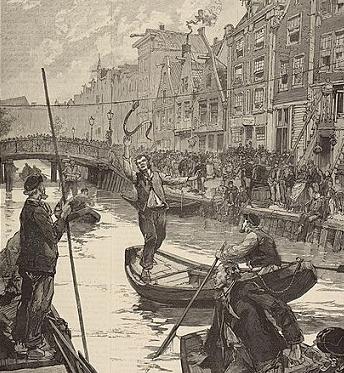Palingoproer on:
[Wikipedia]
[Google]
[Amazon]
 The Palingoproer or the Eel riot was a popular uprising in the
The Palingoproer or the Eel riot was a popular uprising in the
 On Monday, July 26, 1886, riots broke out again. A crowd armed with sticks and rods besieged the police station. The cornered agents had to call in reinforcements and eventually even ask the army to intervene. A terrible fight broke out, streets were broken up and barricades erected. The Jordaan inhabitants pelted the police from their roofs with everything they could lay their hands on. The army fired back with live ammunition. When peace returned the following day, 26 people had been killed and many injured.
On Monday, July 26, 1886, riots broke out again. A crowd armed with sticks and rods besieged the police station. The cornered agents had to call in reinforcements and eventually even ask the army to intervene. A terrible fight broke out, streets were broken up and barricades erected. The Jordaan inhabitants pelted the police from their roofs with everything they could lay their hands on. The army fired back with live ammunition. When peace returned the following day, 26 people had been killed and many injured.
Article
in ''
 The Palingoproer or the Eel riot was a popular uprising in the
The Palingoproer or the Eel riot was a popular uprising in the Jordaan
The Jordaan is a neighbourhood of the city of Amsterdam, Netherlands. It is part of the borough of Amsterdam-Centrum. The area is bordered by the Singelgracht canal and the neighbourhood of Frederik Hendrikbuurt to the west; the Prinsengracht to ...
in Amsterdam
Amsterdam ( , , , lit. ''The Dam on the River Amstel'') is the Capital of the Netherlands, capital and Municipalities of the Netherlands, most populous city of the Netherlands, with The Hague being the seat of government. It has a population ...
on July 25 and July 26, 1886. The riots started when the police tried to thwart playing the forbidden game of eel pulling on the Lindengracht
The Lindengracht is a street and former canal in Amsterdam.
It is in the Jordaan neighborhood of the Centrum district just west of the canal belt.
The canal was back-filled in 1895. It connected the Brouwersgracht with the Lijnbaansgracht.
The ...
. In the uproar that followed, 26 people were killed. Social historians place the events in a context of social tensions as a result of increasing socio-economic differences in 19th-century Amsterdam society.
Background
Palingtrekken, meaning eel pulling or eel drawing, was an old Amsterdam game. A rope was stretched over a canal from and a live eel was hung from it. The players had to sail underneath in boats and try to grab the slippery eel, with the risk of ending up in the water. Eel pulling was banned by the government as "cruel public entertainment". On Sunday, July 25, 1886, a game of eel-pulling had started on the Lindengracht, which had not yet been filled in, when the police intervened. Police officers cut the rope on which the eel was hanging. The spectators then turned on the officers. One officer was pulled into a basement and beaten there. The other agents managed to make their way through the enraged crowd with swords drawn to get reinforcements. The police acted harshly, but only managed to restore order at 10 that night, when most people went home.Monday, July 26
 On Monday, July 26, 1886, riots broke out again. A crowd armed with sticks and rods besieged the police station. The cornered agents had to call in reinforcements and eventually even ask the army to intervene. A terrible fight broke out, streets were broken up and barricades erected. The Jordaan inhabitants pelted the police from their roofs with everything they could lay their hands on. The army fired back with live ammunition. When peace returned the following day, 26 people had been killed and many injured.
On Monday, July 26, 1886, riots broke out again. A crowd armed with sticks and rods besieged the police station. The cornered agents had to call in reinforcements and eventually even ask the army to intervene. A terrible fight broke out, streets were broken up and barricades erected. The Jordaan inhabitants pelted the police from their roofs with everything they could lay their hands on. The army fired back with live ammunition. When peace returned the following day, 26 people had been killed and many injured.
Aftermath
After the uproar, there was a lot of criticism in the press of the police action. According to The New Guide of January 1887, a sack race had been organized the previous Sunday, which the police had turned a blind eye to. Afterwards, the locals decided to organize an eel-pulling contest on the next Sunday. The police could have prevented the riot by acting earlier and more tactfully. Others saw a socialist plot behind the riot, but at the trial of a number of arrested rioters at the end of 1886, the public prosecutor stated that he had found nothing of a plot.References
External links
Article
in ''
De Nieuwe Gids
''De Nieuwe Gids'' (meaning ''The New Guide'' in English) was a Dutch illustrated literary periodical which was published from 1885 to 1943. It played an important role in promoting the literary movement of the 1880s. Its contents covered a wide ...
'' {{in lang, nl
1886 in the Netherlands
Riots and civil disorder in the Netherlands